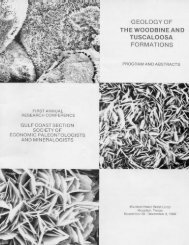Petroleum Systems of Deep-Water Basins - Gulf Coast Section SEPM
Petroleum Systems of Deep-Water Basins - Gulf Coast Section SEPM
Petroleum Systems of Deep-Water Basins - Gulf Coast Section SEPM
You also want an ePaper? Increase the reach of your titles
YUMPU automatically turns print PDFs into web optimized ePapers that Google loves.
New Oceanographic Observations <strong>of</strong> the<br />
<strong>Gulf</strong> <strong>of</strong> Mexico <strong>Deep</strong> <strong>Water</strong>s<br />
Alexis Lugo-Fernandez<br />
Minerals Management Service<br />
Physical Sciences Unit (MS 5433)<br />
1201 Elmwood Park Blvd.<br />
New Orleans, Louisiana 70123-2394<br />
e-mail: alexis.lugo.fernandez@mms.gov<br />
Peter Hamilton<br />
Science Applications International Corporation<br />
615 Oberlin Road<br />
Suite 100<br />
Raleigh, North Carolina 27605<br />
Walter R. Johnson<br />
Minerals Management Service,<br />
Environmental Studies Branch (MS 4041)<br />
381 Elden Street<br />
Herndon, Virginia 20170-4817<br />
Abstract<br />
Recent deepwater current observations in the <strong>Gulf</strong> <strong>of</strong> Mexico suggest this environment is more energetic than previously<br />
observed. Data and modeling results suggest that the <strong>Gulf</strong> <strong>of</strong> Mexico behaves as a two-layer system. Coupling<br />
<strong>of</strong> waters above 1,000 m to waters below is still unresolved and remains a topic <strong>of</strong> further research. The upper layer<br />
circulation is dominated by the Loop Current (LC), Loop Current rings (LCR), and smaller scale eddies. Recent data<br />
reveal a rich field <strong>of</strong> eddies <strong>of</strong> 30–150 km diameters that influence the LCR and shelf-edge currents. The lower layer<br />
circulation is less understood. Currents <strong>of</strong> ~30 cm/s vertically unchanged below 1,000 m, but showing near-bottom<br />
intensification interpreted as topographic Rossby waves (TRW) are reported. These waves have 20–30 day periods,<br />
wavelengths <strong>of</strong> 150–250 km, and propagate westward at about 9 km/day. Recent current measurements at 2,000 m<br />
reveal even stronger speeds (~90 cm/s) 11 m above the bottom and a small vertical shear below 1,000 m typical <strong>of</strong><br />
TRW with periods <strong>of</strong> ~10 days and wavelengths <strong>of</strong> 70 km. In this lower layer, models show the presence <strong>of</strong> deep<br />
cyclone-anticyclone pairs that move westward and interact with the bottom topography, creating intense bottom currents.<br />
Direct observations <strong>of</strong> large furrows, active at present, suggest strong (~100 cm/s) near-bottom currents. The<br />
role <strong>of</strong> steep slopes in the generation <strong>of</strong> large amplitude TRW’s is at present unknown. It is also unknown if the<br />
observed strong ocean currents are responsible for the large furrows at the sea floor.<br />
11

















